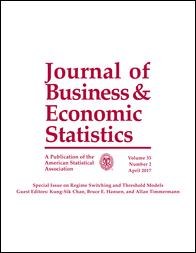
Paap, R., Segers, R. and van Dijk, D. (2009). Do leading indicators lead peaks more than troughs? Journal of Business and Economic Statistics, 27(4):528--543.
-
Affiliated authors
-
Publication year2009
-
JournalJournal of Business and Economic Statistics
We develop a novel Markov switching vector autoregressive model to investigate the possibility that leading indicators have different lead times at business cycle peaks and at troughs. In this model, coincident and leading indicators share a common Markov state process, but their cycles are nonsynchronous, with the nonsynchronicity varying across regimes. An application shows that on average the Conference Board's Composite Leading Index leads the Composite Coincident Index by nearly I year at peaks but by only 1 quarter at troughs. Allowing for asymmetric lead times yields improved real-time dating and forecasting of business cycle turning points. [ABSTRACT FROM AUTHOR]